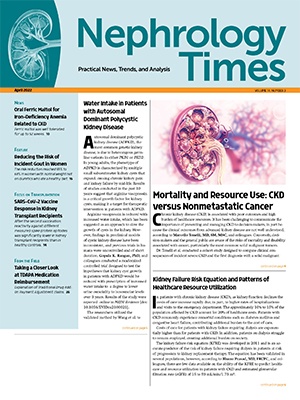
In patients with primary hyperoxaluria type 1 (PH1), there is a positive association between the risk of kidney failure and excretion of urinary oxalate. Lumasiran is an RNA inhibitor therapeutic to lower urinary oxalate excretion in patients with PH1.
During a virtual poster session at ASN Kidney Week 2021, John C. Lieske, MD, and colleagues reported results of an analysis estimating the risk of progression to kidney failure in patients with PH1 treated with lumasiran, compared with patients not treated with lumasiran. The poster was titled Modeling the Risk of Progression to Kidney Failure in Patients with Primary Hyperoxaluria Type 1 Treated with Lumasiran Relative to a National History Cohort Not Treated with Lumasiran.
A skewed-normal distribution of 24-hour urinary oxalate values for patients with PH1 was simulated based on reported urinary oxalate values from the Rare Kidney Stone Consortium (RKSC) PH Registry among patients not in kidney failure at diagnosis and who did not receive lumasiran. A loglinear model of post-lumasiran treatment steady-state urinary oxalate as a function of baseline urinary oxalate was built using data from the ILLUMINATE-A trial of lumasiran. The distribution of steady-state, on-treatment urinary oxalate values for RKSC patients was then predicted by applying this model to the stimulated 24-hour urinary oxalate excretion of the RKSC cohort, considered as baseline. The number of kidney failure events per 100 patients in the RKSC PH1 cohort who had received lumasiran was estimated using a risk model of kidney failure as a function of 24-hour urinary oxalate excretion, based on Kaplan-Meier curves of renal survival reported from the RKSC.
In the absence of lumasiran treatment, the mean 24-hour urinary oxalate excretion for the RKSC PH1 cohort was 2.2 mmol/24 hr/1.73 m2, and was predicted to decrease to 0.62 mmol/24 hr/1.73 m2 in a model stimulating the effect of administration of lumasiran
In the model for patients not treated with lumasiran, the predicted number of kidney failure events per 100 patients at 10, 20, and 30 years was 10 (95% confidence interval [CI], 4-23), 32 (95% CI, 19-50), and 42 (95% CI, 27-59), respectively. In the model of lumasiran treatment, the estimated cumulative number of kidney failure events per 100 patients was 4 (95% CI, 1-12) at 10 years and remained unchanged at 20 and 30 years.
In conclusion, the researchers said, “This analysis predicts a long-term reduction in kidney failure risk among PH1 patients treated with lumasiran, assuming prompt treatment at diagnosis.”
Funding for this analysis was provided by Alnylam Pharmaceuticals.
Source: Lieske JC, Mara KC, Danese DS, et al. Modeling the risk of progression to kidney failure in patients with primary hyperoxaluria type 1 treated with lumasiran relative to a natural history cohort not treated with lumasiran. Abstract of a poster presented at the American Society of Nephrology virtual Kidney Week 2021 (Abstract PO1319), November 2021.





 © 2025 Mashup Media, LLC, a Formedics Property. All Rights Reserved.
© 2025 Mashup Media, LLC, a Formedics Property. All Rights Reserved.